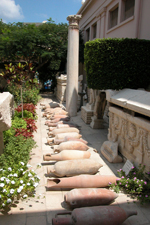
Le Centre Alexandrin
d'Étude des Amphores
The Alexandrian Centre for Amphora Studies


CEAlex - USR 3134
| Présentation | Amphores | Anses timbrées | Fouilles | Publications | Bibliothèque CAEA CAEA Library |
Ressources en ligne | Plan du site | Mise à jour |
Présentation / Introduction
| Présentation générale / General introduction |
| Introduction générale sur les amphores trouvées à Alexandrie / General Introduction to amphorae found at Alexandria |
INTRODUCTION GÉNÉRALE SUR LES AMPHORES TROUVÉES À ALEXANDRIE
General Introduction to amphorae found at Alexandria
Kaan Senol*
After the foundation of the city by Alexander the Great in 331 BC, Alexandria became the most attractive commercial harbour of the Hellenistic world by using her geographic advantages. Alexandria flourished and became a famous consumption centre in the Mediterranean basin as a result of the efforts of the Ptolemaic dynasty. She deserved the praise of Strabo, who called her the greatest emporium of the inhabited world during the Hellenistic period. Due to extensive trade connections, very many of the products carried by amphorae reached the city, either to be consumed there or to be transported to India via Lake Mariout, the Nile, desert trails and finally the Red Sea. These routes were used both for exporting and importing goods, and very many different types of amphorae have been found during the excavations undertaken in the city. This variety can be witnessed in the amphora stamps, of which the largest collection in the world is held in the Graeco-Roman Museum of Alexandria.
Importance of Alexandria as a production centre
Alexandria was not only a city of consumers, but a production centre as well. Not less than 28 amphora workshops have been discovered, along with villae rusticae, around Lake Mariout, and this hinterland of the city gained importance as one of the most important wine production areas in Egypt. Egyptian wine was carried in AE 1 and AE 2 (Amphores Egyptiennes Type 1 and 2) during the Hellenistic Period (Figs. 1 & 2). The amphora types were radically changed during the Roman Period in Egypt. They used longer but unusual bi-conical forms as the characteristic forms, called AE 3 (Fig. 3). By changing the shape and scale of the amphorae, the AE 4, derived from DR 2-4 of that period, were used for the famous Taeonitic wine, and we have found large quantities of these in the salvage excavations of CEAlex in Alexandria (Fig. 4). The history of Egyptian wine continues in another type called AE 5/6 or LR 5/6 that were also used on the Syrian coast (Fig. 5). The only type of which we have not found traces of production on the shores of Lake Mariout is AE 7, which was as widespread as the previous type and widely produced and distributed in Middle Egypt (Fig. 6).
Amphorae as epigraphic material
Amphorae are considered as evidence of ancient commerce as they were used to carry wine, olive oil, fish sauces, salted fish, meat, fruits, vegetable oils, spices and almost any goods that we may imagine. The painted inscriptions (dipinti) and the engravings (graffiti) on the amphorae indicate the produce of these containers, the actual capacities, the names of the producers or consumers and the quality of the products inside them. We have a varied collection of dipinti conserved due to the extraordinary climate of Egypt, mostly from the fifth and sixth centuries AD found in the Necropolis of Gabbari (Figs. 7 & 8).
